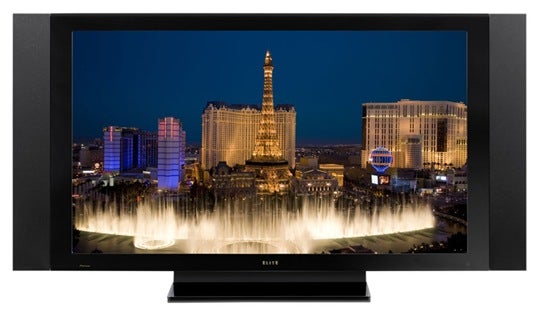Plasma TV’s Identity Crisis
The Upshot: Under $500 for a 42-inch screen?

We may earn revenue from the products available on this page and participate in affiliate programs. Learn more ›
How could a technology be failing if it performs better and costs less than its competitor? That’s probably what plasma TV makers keep asking themselves, and one we’re been thinking about since both Pioneer and Vizio pulled out of the business last month. So we asked a few folks in the biz for their thoughts.
One possible answer is that the tech is pulled in two directions—toward both videophiles and bargain hunters—while LCD shoots up the middle and sweeps the most customers. (According to DisplaySearch, companies shipped about 33.5 million LCDs in the last quarter or ’08 vs. about 4.4 million plasmas—though many of those LCDs were small screens.)
Plasma probably didn’t look like bargain tech in the early aughts, when high-flyers were spending $5000 for a 42-inch screen. But remember that the first 40-inch LCD debuted at a forehead-smacking $10,000 back in 2004.
The huge price difference should have helped plasma, but instead it hurt. If LCD cost twice as much, it must be better, right? And as the prices of big LCDs kept dropping, the aspirational product became attainable. Why go for that old plasma junk when the new LCDs are coming out? (Ironically, plasma is actually the younger technology.) The fact they are literally brighter and shinier didn’t hurt LCDs, either.
One of the big remaining plasma makers, LG, is clearly torn about how, or whether, to continue. In response to my questions, their US spokesperson, Tim Alessi gave a positive spin, saying “Both plasma and LCD have unique benefits that will satisfy the high-end consumer…LG strives to offer consumers a wide choice by offering both of these outstanding technologies.” (Execs from LG, Samsung and Panasonic all elected to send me carefully crafted written replies rather than grant live interviews.)
But candid doubts came out in an article in the Korea Times in which an unnamed “LG executive” said, “Considering profitability, the plasma TV business won’t be a cash-cow. Restructuring it is one possible option, though the timing is not ripe.”
How do you sell it?
Some companies like Vizio capitalized on cheap plasmas, selling oodles at Costco. But as LCD prices kept dropping, the meager savings on un-hip plasma didn’t seem to be worth it. And Vizio left the plasma business in February.
At the other extreme, you had Pioneer, which refused to make LCD on principle, because the engineers thought it looked like crap compared to plasma–specifically in terms of color, contrast and smoothness of motion.
Pioneer was one company that succeeded (for a while) in branding plasma as the high-end product, the choice of “videophile” connoisseurs. And I don’t just mean well-paid yuppies. I’m mean people who really know video quality, like Dark Knight director Chris Nolan and his cinematographer Wally Pfister (who also filmed the 2003 remake of The Italian Job), chick-flick photographer John Bailey (He’s Just Not That Into You, The Sisterhood of the Travelling Pants) and the cinematographers from TV’s Heroes and Mad Men.
In fact, post-production house Company 3—which handled blockbusters like Dream Girls, Sweeny Todd, Transformers and 300—tore out it’s old Sony CRT monitors and replaced them with high-end Pioneer Kuro TVs to use for refining the video. I hope they bought a few spares, because Pioneer left the entire TV business in February.
Last week, I bumped into a former exec from Pioneer’s US branch who didn’t want me to mention his name, but had no qualms about mentioning his opinions. He thinks the brand failed precisely because the bosses back in Japan couldn’t decide how to market plasma. Pioneer sets were way pricey—up to twice the cost of competitors. But that worked for high-end buyers who could see the subtle quality difference and would shell out for it.
Plasma was always a money-loser for Pioneer. But the US branch was doing pretty well compared to other divisions, he said—based largely on the ultra-pricey Elite brand sold at specialty A/V stores. “But Pioneer was producing too many TVs and also selling at lot at Best Buy. The set was twice the price of the Panasonic right next to it.”
When Pioneer got out of the business, Panasonic snatched up a lot of the talent, hiring over 200 of Pioneer’s TV engineers. The exec wasn’t optimistic about that leading to Pioneer-like quality in Panasonic plasmas, though. “Panasonic didn’t want to improve the tech,” he said. “They wanted to make it cheaper.”
But is that so bad? In the midst of a long recession, we still have our gadget lust—especially for TVs. (Sales still grew in the past year.) Josh Kairoff, Pioneer’s former head of display engineering in the US probably did more than anyone to perfect video quality, but he recognizes that most people are not that fussy.
“Home theater and AV enthusiasts have always been about technology, while Bob and Jill consumer really don’t care,” he said. “They just want to watch Oprah and CSI and American Idol. Whatever provides them moving images to zone out on for the lowest cost per square inch wins.”
Kairoff predicts 42-inch plasma screens dropping under $500 in the near future. And as a side benefit, they will most likely look better than the pricey LCDs they compete against.